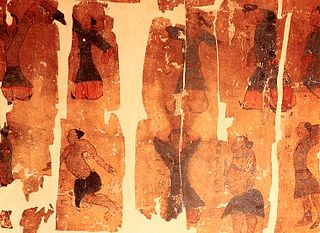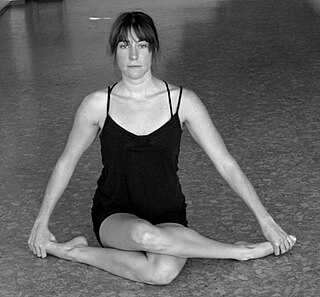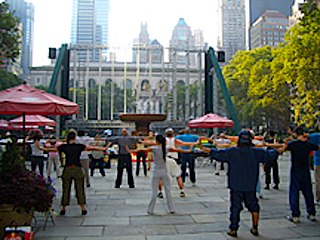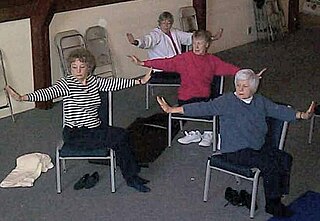
Kalaripayattu is an Indian martial art that originated in Kerala, a state on the southwestern coast of India. Kalaripayattu is known for its long-standing history within Indian martial arts, and is one of the oldest surviving martial arts in world.

Pilates is a type of mind-body exercise developed in the early 20th century by German physical trainer Joseph Pilates, after whom it was named. Pilates called his method "Contrology". It is practiced worldwide, especially in countries such as Australia, Canada, South Korea, the United States and the United Kingdom. Pilates uses a combination of around 50 repetitive exercises to spur muscle exertion. Each exercise flows from the "five essentials": breath, cervical alignment, rib and scapular stabilization, pelvic mobility, and utilization of the transverses abdomens. Each exercise is typically repeated three to five times. As of 2023, over 12 million people practice Pilates.

Seiza is the formal, traditional way of sitting in Japan. It involves a specific positioning and posture in a kneeled position so as to convey respect, particularly toward elders. It developed among samurai during the Edo period and was later widely adopted by the public.

Daoyin is a series of cognitive body and mind unity exercises practiced as a form of Daoist neigong, meditation and mindfulness to cultivate jing (essence) and direct and refine qi, the internal energy of the body according to Traditional Chinese medicine. These exercises are often divided into yin positions, lying and sitting, and yang positions, standing and moving. The practice of daoyin was a precursor of qigong, and was practised in Chinese Taoist monasteries for health and spiritual cultivation. Daoyin is also said to be a primary formative ingredient in the well-known "soft styles" of the Chinese martial arts, of Taiji quan, and middle road styles like Wuxingheqidao.

Lethwei or Burmese boxing is a full contact combat sport from Myanmar that uses stand-up striking including headbutts. Lethwei is considered to be one of the most brutal martial arts in the world, as the sport is practiced bareknuckle with only tape and gauze while fighters are allowed to strike with their fists, elbows, knees, and feet, and the use of headbutts is also permitted. Disallowed in most combat sports, headbutts are important weapons in a Lethwei fighter's arsenal, giving Lethwei its name of the "Art of nine limbs". This, combined with its bareknuckle nature, gave Lethwei a reputation for being one of the bloodiest and most violent martial arts. A vast majority of Lethwei fighters originate from the Karen ethnicity.

Maung Gyi is a Burmese martial artist that introduced Bando into the United States. He is the chief instructor for the American Bando Association.

In Chinese martial arts, there are fighting styles that are modeled after animals.

The horse stance is a common posture in Asian martial arts. It is called mǎbù (馬步) in Chinese, kiba-dachi (騎馬立ち) in Japanese, and juchum seogi or annun seogi in Korean. This stance can not only be integrated into fighting but also during exercises and forms. It is most commonly used for practicing punches or to strengthen the legs and back. The modified form of horse stance, in which heels are raised, is fighting stance in International Karate Tournaments. The Chinese form of horse stance is fighting stance which changes into front stance while using hip rotation to develop punching force.
Indian martial arts refers to the fighting systems of the Indian subcontinent. A variety of terms are used for the English phrases "Indian martial arts", deriving from ancient sources. While they may seem to imply specific disciplines, by Classical times they were used generically for all fighting systems.

A split is a physical position in which the legs are in line with each other and extended in opposite directions. Splits are commonly performed in various athletic activities, including dance, figure skating, gymnastics, contortionism, synchronized swimming, cheerleading, martial arts, aerial arts and yoga as exercise, where a front split is named Hanumanasana and a side split is named Samakonasana. A person who has assumed a split position is said to be "in a split", "doing a split", or "doing the splits".

Salabhasana or Purna Salabhasana, Locust pose, or Grasshopper pose is a prone back-bending asana in modern yoga as exercise.

Bando is a defensive unarmed martial art from Myanmar. Bando is sometimes mistakenly used as a generic word for all Burmese martial arts, but it is only one martial art; Burmese fighting systems collectively are referred to as thaing.
The origins of Asian martial arts are diverse and scattered, having roots in various regions of Asia. Various Asian martial arts reference the study of animal movements as inspiration for martial arts techniques.

Huiyen Lallong is a traditional Meitei martial art form. It is one of the Indian martial arts, originating from Manipur. In the Meitei language, Huiyen means war while Lallong or Lanlong can mean net, knowledge or art. Huiyen Langlon consists of two main subforms: Thang-Ta and Sarit Sarak. The primary weapons of Huiyen Lallong are the Thang (sword) and Ta (spear). The spear can be used in its non-missile form while up close, or thrown from afar. Other weapons include the shield and the axe. Unarmed combat incorporates hand strikes, kicks, and grappling (Mukna). Because of Manipur's cultural similarity and geographical proximity with Myanmar, huyen langlon is closely related to Burmese bando and banshay.

Choi Kwang Do is a martial art developed by Choi Kwang-jo. The style relies more on flexibility and fluidity of movement as opposed to the more rigid lines of some other martial arts. To achieve this it employs yoga-based stretching to develop the flexibility of practitioners.

Yin Yoga is slow-paced style of yoga as exercise, incorporating principles of traditional Chinese medicine, with asanas (postures) that are held for longer periods of time than in other styles. Advanced practitioners may stay in one asana for five minutes or more. The sequences of postures are meant to stimulate the channels of the subtle body known as meridians in Chinese medicine and as nadis in Hatha yoga.

Qigong ,, chi kung, chi 'ung, or chi gung is a system of coordinated body-posture and movement, breathing, and meditation used for the purposes of health, spirituality, and martial arts training. With roots in Chinese medicine, philosophy, and martial arts, qigong is traditionally viewed by the Chinese and throughout Asia as a practice to cultivate and balance qi, translated as "life energy".
The traditional martial arts of the Mainland Southeast Asia are related to one another, and as a group to Indian martial arts. The most salient common feature is Mainland Southeast Asia kickboxing. The region of Mainland Southeast Asia is believed to be the land of Suvarnabhumi that ancient Indians mentioned in Buddhist text and Hindu text. In 790 A.D., a Khmer prince who grew up abroad by the name of Jayavarman II returned to unify the Khmer civilization. In 802 A.D., Jayavarman II established the Khmer Empire, the precursor to modern Cambodia, and declared himself the Chakravatin. Around 850 A.D., Pagan, the ancestor of modern-day Burma, was established by Tibeto-Burman speakers. For 200 years, Pagan remained a small principality until the reign of King Anawrahta. In 1238 A.D., Thailand's first state, Sukhothai, was started when the residents declared independence from the Khmer Empire. In 1353 A.D., Laos's first state, Lan Xang, was started by Fa Ngum with the assistance of the Khmer from Angkor.
Namaste Yoga is an instructional yoga as exercise television series produced by Namaste TV, a division of Omnifilm Entertainment, headquartered in Vancouver. In 2021, the company launched an online fitness platform and app called Movement by NM where Namaste Yoga episodes are available for streaming.

Accessible yoga is a form of modern yoga as exercise with adapted asanas designed to be suitable for people who are unable to follow a standard yoga class through age, illness, or disability. It includes various forms of what has been called Chair Yoga, and has also been described as adaptive yoga.




















